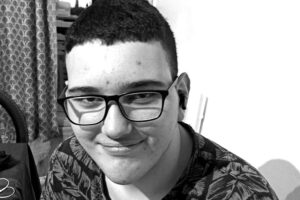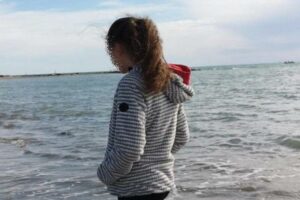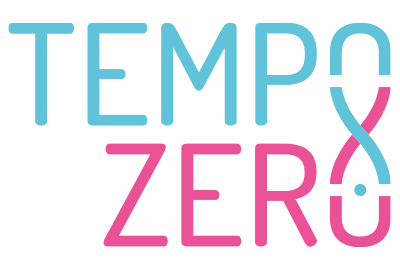


The Story of Carola

There are only 200 people in the world like Carola, 16, from Fiumicino, and 30 in Italy. Two hundred children and adolescents are condemned because there is still no cure for Lafora disease, a genetic alteration that causes sugars to accumulate, especially in the brain, due to the absence of proteins involved in glycogen metabolism that should synthesize them.
Carola is a brilliant girl. High grades in school, a passion for fin swimming that she practices competitively. A full teenage life, growing up in Fiumicino with Harry Potter books, the company of two siblings, and the love of her parents, Simona and Lorenzo. When the first epileptic seizure sounded the alarm, she was 13 and finishing middle school, with the prospect of attending high school. Suddenly, her days became uphill battles. The seizures became more frequent, and the medications started to fail.
What was once simple was no longer so: a math problem, walking, thinking. Slowing her body and mind is a very rare disease: Lafora disease. It’s a process that starts at birth, continues silently for a long time until the first symptoms appear. It disrupts movements, weakens, deteriorates cognitive abilities, and doesn’t stop. The life expectancy for these kids is only a few years, averaging 5-10 years from the onset of tangible symptoms. For Carola, it has already been two and a half years since the diagnosis confirmed by a genetic test, after an initial period where the disease was treated as juvenile myoclonic epilepsy.
Today, at 16, she continues to fight. Like her, about thirty patients in Italy, a country with a significant concentration of cases, are fighting. Considering there are only a few hundred cases worldwide, they are too few to attract funding or the interest of major pharmaceutical companies and create a critical mass for research. Their hope was pinned on a promise of a drug using an RNA platform, which the American company Ionis Pharmaceuticals had started testing. First in vitro tests, then on mouse models. “We anxiously awaited the eagerly anticipated milestone of starting the clinical trial in humans,” Carola’s uncle, Alessandro Ippoliti, told Adnkronos Salute. “A patient registry was also started,” a very important study on the natural history of the disease documented in every aspect on about 30 patients. But something went wrong.
The future dreams of Lafora kids shattered over a few lines written by the company to communicate an indefinite postponement of the clinical phase: “Unfortunately, due to organizational constraints, particularly in human resources needed to start a new clinical program, we write to inform you that the study’s start this year is unlikely. We continue to explore potential alternative options.”
“But we do not give up,” assures Carola’s mother, Simona Fochetti. “We mainly have two possible paths and ask for help to make at least one a reality.” The goal could be to bring the research on this drug to Italy.
We ask that some company in our country come forward to help us,” say both Carola’s uncle and mother
It seems that Ionis Pharmaceuticals is willing to grant the patent use,” continues mother Simona. “In practice, they tell families to find a company that will conduct the trial, and this whole operation would cost, according to the intermediary company, 10 million dollars.” “It’s all very difficult,” she laments. “What can we parents do? It’s a pity because the company had the protocol ready, already approved by the FDA. Twenty kids worldwide would have been chosen for the trial, among those in better conditions. Three centers were involved, one in America, one in Spain, one in Italy,” at Bellaria Hospital in Bologna. Now, yet another stop. “But time flies for our children.”
American families of these patients, with the association Chelsea’s Hope, have pushed hard for the U.S. government to fund research on this disease, explains Roberto Michelucci, director of the Neurology Unit at Bellaria Hospital – Irccs Institute of Neurological Sciences of Bologna. “And there was a big grant and funding from the NIH (National Institutes of Health) and an effort from all the leading scientists in the field to understand the disease mechanism.”
Today, continues the specialist who has studied the pathology for many years, “we know the responsible genes and altered proteins, we know there is a glycogen metabolism disorder, that glycogen has an alteration in its degradation, causing it to accumulate as Lafora bodies inside cells, leading to dysfunction and symptoms: epilepsy, muscle jerks, cognitive deterioration, difficulty walking. The Ionis drug would modulate the activity of an enzyme that produces glycogen, preventing further accumulation. In animal models, it stops and partially regresses the disease. There is strong evidence that the drug, which has also passed primate toxicology tests, can work.”
At the end of 2019, continues Michelucci, “it seemed imminent that the clinical trial would start. Then there were delays. The company has many orphan disease drugs and at some point communicated that this was no longer a priority and they were looking for a partnership with another company to manage the clinical transition. The drug must be administered directly into the brain’s ventricles because it doesn’t cross the blood-brain barrier. Therefore, a study requires significant funds, structure, and important competencies.”
This research on Lafora, continues the scientist, “had also produced two other drugs that serve to degrade and dissolve Lafora bodies, enzymes carried with monoclonal antibodies, very important, developed by Valerion, which work in animal models, but the company didn’t survive COVID, and now a startup is launching to carry them forward, but funds and partnerships are needed. We are in a phase where the most promising drugs are on hold.” Therefore, other quicker options are being explored.
“For example,” explains Michelucci, “there is a drug already approved and used for Pompe disease.” It’s an enzyme replacement therapy called Myozyme*, produced by Sanofi. “The problem is that Pompe disease affects muscles and the heart, Lafora affects the brain. And this drug is not designed to cross the blood-brain barrier. We hope it partially does because in these people with epilepsy, this barrier might be altered. The drug administered at the brain level in animals seems to work, and talks with Sanofi have been started to request a compassionate use study, but we have no official responses yet. The Italian Medicines Agency Aifa is also involved and will have to make its evaluations.”
We want a perspective. Our children are aware of what’s happening to them. They ask us: why could I do this before and now I can’t?
« Carola hasn’t left the house for 24 months waiting for this cure to arrive. We’ve held on, but now we are in the phase of despair. They ask us for more time, but we don’t have it.” This is why one of the two associations in Italy representing these patients is called ‘Zero Time’. “It was founded to raise awareness, collect funds, and do something to save our kids. We don’t want more years to pass and it becomes too late,” concludes Simona.
SUPPORT RESEARCH
We need your help to raise funds for the development of a phase 1/2 (safety and efficacy) ASO drug specifically designed for Lafora disease.



